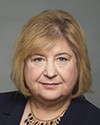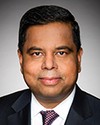Good morning. Greetings. I am Abram Benedict, Grand Chief of the Mohawk Council of Akwesasne.
I want to acknowledge the territory that we are on here today, a territory in which the Algonquins and the Haudenosaunee have historically met.
The Akwesasne territory I come from is a geographically unique place that is about three hours east of here. The territory straddles the international boundary between United States, upstate New York and Canada while straddling the Ontario and Quebec provincial line, the political borders which were all well after the community had been contemporarily occupied and the borders were drawn without community consent or consultation.
The Mohawk Council of Akwesasne is recognized under the Canadian portion of Akwesasne as the elected system, and it is comprised of 12 district chiefs and a grand chief, which position I hold now.
The Mohawk community of Akwesasne is a community of over 20,000 community members with ancestors who have inhabited the St. Lawrence Valley for centuries. The Mohawk Council of Akwesasne currently has 12,500 registered members. The community consists of 3,200 hectares of land as well as 60 kilometres of waterways that connect many water tributaries to what is known at the St. Lawrence River, which we are also on today.
There are a few claims we have active within Akwesasne, one of which is Canada's second largest thus far claim amount being offered, which is the Tsikaristisere-Dundee land claim. Currently the Government of Canada has offered $239 million for its breach of fiduciary responsibility for the misuse of 18,200 acres of land in the Dundee, Quebec, portion of Akwesasne.
We have a Seaway land claim, which is from the construction of a hydro dam in the international shipping channel known as the Seaway shipping channel, which was constructed in the 1950s. At that time, when the two governments of Canada and the United States viewed this project as a great success and an economic engine to join two countries, the reality was that in our community hundreds of metric tons of our land were being taken away and the lands were being expropriated and small amounts of compensation were offered to each individual member of the community. We have a claim against Canada for this.
The North Shore land claim, which is another claim that we are continuing to research, was recently submitted but unfortunately rejected under the current policies that exist. The Baxter and Barnhart claim is a very unique claim because it is a claim for an island that was in our traditional territory but then was later on traded with the United States. Now the Government of Canada maintains it is outside of their jurisdiction. And there's the New York state claim in which we are partners, we are applicants on it on as well as the Saint Regis Mohawk tribe and the Mohawk Nation Council of Chiefs. There are numerous other claims that our community has still in the research phase.
To assist the work of the Mohawk Council we have created an office called the Aboriginal Rights and Research Office, ARRO. The ARRO staff had been working on land claims during the 1980s with other departments and it was more formally established as a dedicated research office in 1989. Our community has been funding it, as has in part the government, based on submissions and approvals of resources, but for the most part we have funded it entirely on our own. The current staff includes a manager, four researchers and one records administrator.
With the dedicated assistance of our Aboriginal Rights and Research Office, the Mohawk Council and the community of Akwesasne have settled an Ontario Power Generation claim in 2008. As well, we have settled the Easterbrook claim in 2012.
Our core approach is a nation-to-nation approach where indigenous first nations communities have a level playing field when dealing with the Government of Canada in regard to being able to equitably resolve outstanding historical land claims. The tools required would increase the funding resources to create a joint process in policy implementation as well as development, independent services, and equal access to resolution services. This is something that was available in the past, where you were able to acquire the services of an outside facilitator during discussions. Now that has been brought back in and the dispute mechanism that's available is actually another department.
On reframing the approach to restoring lands, the return of lands, I know that a number of you have remarked that as you've travelled across the country this week other communities have said that it's not always about the money, it's about the return of land.
I'm joined here today by Mr. Phillipp White-Cree, who will provide more information about the unique aspects of Akwesasne, as well as our land claim issues. He is the acting manager from our department of aboriginal rights and research.




